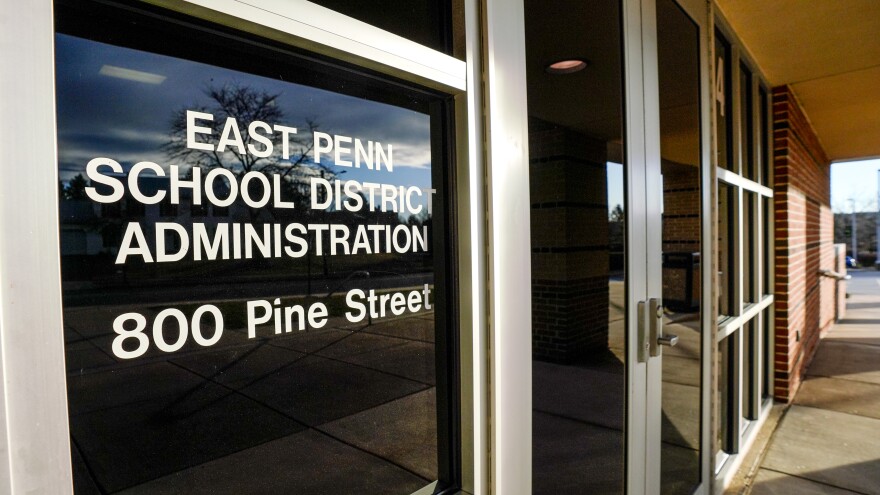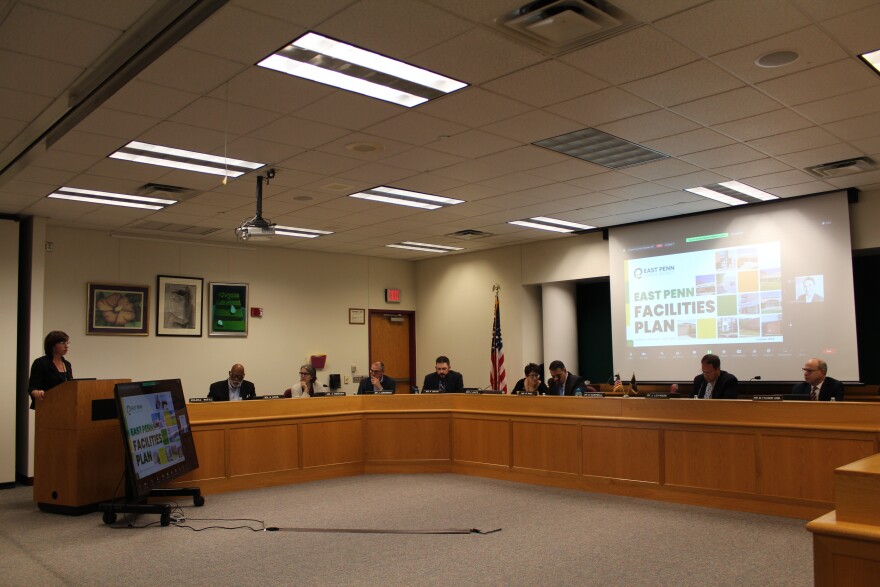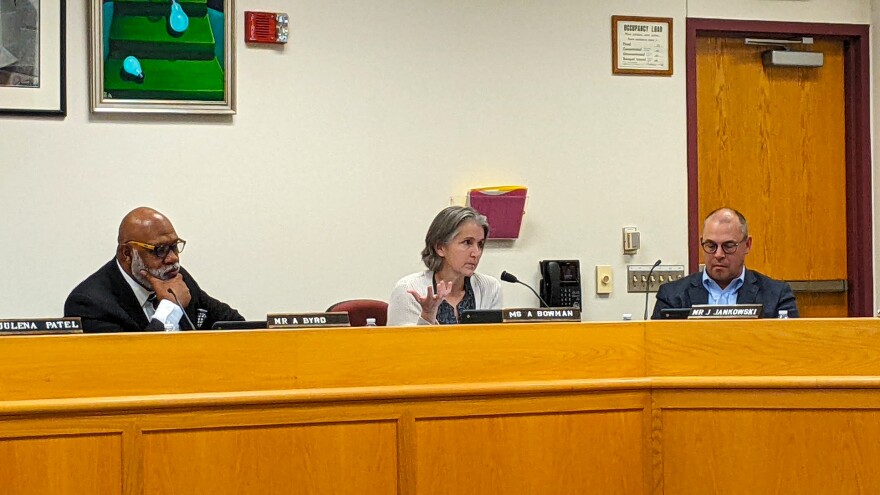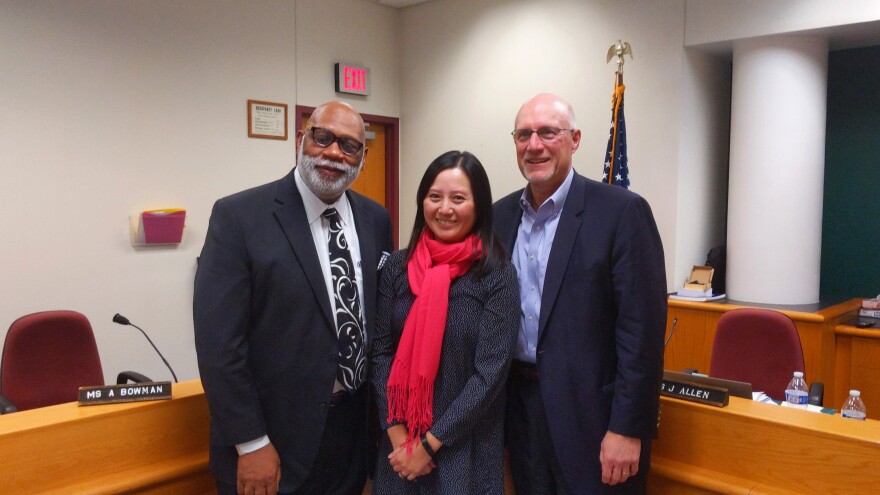- East Penn School Board voted Monday to realign grades K-8 as the decision-making process to expand district facilities continues
- Once renovations are complete, the district will move all fifth- and sixth-graders to Eyer Middle School and all seventh- and eighth-graders to Lower Macungie Middle School, with additions and changes to each building
- The board also voted on an early budget-related measure and said farewell to outgoing members
EMMAUS, Pa. — East Penn schools students will be brought together starting in fifth grade, rather than waiting until high school, after the school board voted 8-1 Monday to realign K-8 grades.
Administrators and consultant partners presented massive facilities expansion to the board at its Oct. 24 meeting that included a decision whether to address overcrowding in non-high school grades via primarily redistricting and expansions, or by realigning the district's grades to move all fifth- and sixth-graders to Eyer Middle School and all seventh- and eighth-graders to Lower Macungie Middle School.
There would be additions and changes to each building to accommodate the change, along with some elementary school redistricting.
"This decision, it kind of goes without saying, is one of the biggest, if not the biggest decision, that we as a board have made in my time."East Penn School Board member Adam Smith
On Monday, the board voted to pursue the realignment plan as it continues to work through a multi-year process to reshape the district as a result of overcrowding concerns.
"The K-8 realignment option is certainly the one that is going to require the most planning because we're redesigning a new program," Superintendent Kristen Campbell said Monday.
"So certainly, the direction is helpful because we now know that we can focus our attention on bringing in stakeholders and continuing with that planning."
Campbell said the next step would be to partner with an engineer to plan expansion options, and said it will be several years before renovations at the middle schools are completed, allowing the realignment to occur.
She emphasized that it's still in the preliminary planning phase and the board will have to make many more decisions before things start to be felt by the community.

"This decision, it kind of goes without saying, is one of the biggest, if not the biggest decision, that we as a board have made in my time," board member Adam Smith said.
Expansion efforts are meant to bolster the district against what the administration and its partners project as overcrowding from enrollment growth from 8,005 in 2022 to 8,486 in 2032.
"Anybody who wants to know if our schools are overcrowded, should just go to LMMS during class change and see what they think, or the high school during class change, or any of our elementary schools that are out of space," board member Alisa Bowman said.
The board also unanimously accepted the feasibility study presented at the prior meeting, which will be used as a basis for moves going forward.
Administrators at the prior meeting said realigning the grades would create benefits by getting those grades together much earlier, and lead to more opportunities for collaboration among each grade's teachers.
Board members sound off on decision
Only school board member Jeffrey Jankowski voted against the realignment.
"I think my concern is that students are going to be missing out on opportunities because of the number of students in the same grades," Jankowski said.
He said he preferred a more equal division of students between the middle schools.
During the prior meeting, some concerns centered on adding a significant facility transition for students, and how that could specifically impact autistic support and special education.

But the other board members voiced optimism and necessity in the decision.
"I think it addresses a number of things in a very clean way," outgoing board member Paul Champagne said.
"The K-4 model alleviates the issue of over-capacity on our elementary schools without having to put any of our elementary schools through construction build out. It provides, I think, more focused attention on those students."
Champagne and other board members emphasized that deciding to bring grades 5-8 together could result in more cohesiveness and bolster extracurriculars by giving more opportunities for fifth-graders and better connecting students in the same grade who in the current system are separated between elementary and middle schools.
"Maybe there's a need for a club that only had two kids in one school and three kids at another," Smith said. Now you have five that have a small community of learners centered around a common interest that we can make a club where we didn't have one before.
"I'm very sad that I won't be able to see my kids go through that kind of a setting, but I darn sure wish they had that opportunity. And I wish that I had the opportunity to work in that kind of a setting."
"Anybody who wants to know if our schools are overcrowded, should just go to LMMS during class change and see what they think, or the high school during class change, or any of our elementary schools that are out of space"Board member Alisa Bowman
At the prior meeting, it was discussed that students in the seventh-eighth-grade building would be separated into two "teams" based on elementary school boundaries for arts and some athletics, while transportation would be separate for grades 5-6 and 7-8.
Board President Joshua Levinson also said realignment saw majority support in the stakeholder survey conducted by the district during its facilities study.
Decision just a starting point
Bowman and others acknowledged messages of concern and questioning that parents worried about how it may impact their children sent to the district since the last meeting.
"I understand the anxiety of different people who wrote to us; if I was in their situation, I would share the same anxiety," Bowman said.
"We are only voting to just move forward with our continued study, maybe picking one option to study more than the other options that were on the table."

She noted the vote for realignment will not be the action that sends currently enrolled children to a different school, and emphasized that the cost of hundreds of millions of dollars cited during the facilities study presentation were not set in stone.
Bowman also said she wants to ensure people who now could walk to their school will not have to worry about shifting to a school where they could not.
She also said she hoped that with realignment of elementary schools and greater frequency of activity buses, more children can take part in extracurriculars.
Campbell said work to begin the projects including engineering preparations would likely start in early 2024.
Saying farewell, and early budget actions
The board also voted not to exceed the Act 1 index for the following school year's budget, meaning that it limits tax increases to below the index's set maximum.
This year, that would be a real estate tax increase of 6.2%, which Robert Saul said would increase revenue about $7.3 million dollars.
Board members and Superintendent Campbell took time to commend outgoing board members, saying each had left a great mark on the school district and community because of their knowledge and contributions.

The departing board members responded by voicing optimism for the district going forward.
The recent school board elections resulted in incumbents Levinson and Jankowski retaining their seats, running on a victorious slate alongside Democrats Gabrielle Klotz and Shonta Ford, and Republican Timothy Kelly.


